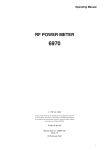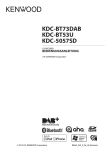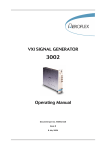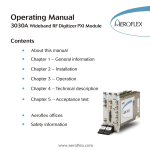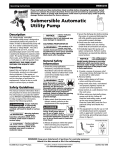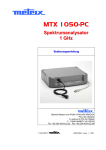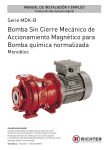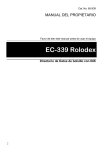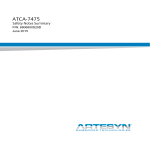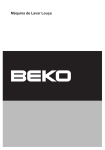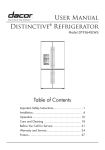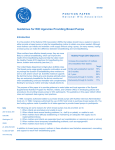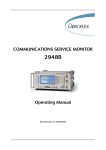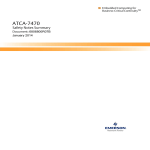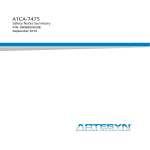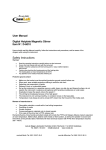Download AXRF RF Subsystem and AutoCal Unit Getting
Transcript
AXRF RF Subsystem and AutoCal Unit Getting Started Read this before handling or powering up the instrument! Contains important safety precautions Document part no. 47090/303 AXRF RF Subsystem and AutoCal Unit Getting Started © Aeroflex Limited 2015 Longacres House Six Hills Way Stevenage SG1 2AN UK No part of this document may be reproduced or transmitted in any form or by any means, electronic or mechanical, including photocopying, or recorded by any information storage or retrieval system, without permission in writing by Aeroflex Limited (trading as Cobham Wireless and hereafter referred to throughout the document as ‘Cobham’). Document no. 47090/303 Issue 2 27 April 2015 Preface About this document This guide covers the AXRF RF Subsystem and the AutoCal Unit. It contains safety precautions that you should observe before and during operation of the instruments. It provides a very basic introduction to the instruments. For full details of all the capabilities of the instruments, please refer to the AXRF RF Subsystem and AutoCal Unit User Manual (document no. 47090/270) on the supplied CD-ROM 46886/100. ii Preface Contents About this document .................................................................................................................................................. ii Associated documentation ..............................................................................................................................................iv Safety instructions ........................................................................................................................................................ v Invalid cal data/damage to modules ............................................................................................................................v Precautions ........................................................................................................................................................................vi Précautions ........................................................................................................................................................................ix Vorsichtsmaßnahmen .............................................................................................................................................. xii Precauzioni ...................................................................................................................................................................... xv Precauciones .............................................................................................................................................................. xviii Introduction ......................................................................................................................................................................1 AXRF RF Subsystem .............................................................................................................................................................. 1 AutoCal Unit ............................................................................................................................................................................. 1 Installation requirements ........................................................................................................................................ 2 AXRF RF Subsystem cooling............................................................................................................................................. 2 18-slot chassis ................................................................................................................................................................. 2 Connecting to supply........................................................................................................................................................... 2 AXRF RF Subsystem ...................................................................................................................................................... 2 AutoCal Unit ..................................................................................................................................................................... 2 Disconnecting device................................................................................................................................................... 2 AXRF RF Subsystem configuration and cabling ..................................................................................................... 4 Software ...............................................................................................................................................................................5 Required software.................................................................................................................................................................. 5 Software installation ............................................................................................................................................................ 5 Programming the AXRF RF Subsystem ....................................................................................................................... 5 General information ..................................................................................................................................................... 5 AXRF control software ........................................................................................................................................................ 5 AXRF control description ........................................................................................................................................... 5 iii Preface Associated documentation If you want to… Refer to… Learn about AXRF RF Subsystem and AutoCal Unit AXRF RF Subsystem and AutoCal Unit User Manual Part no. 47090/270 On AXRF System CD-ROM 46886/100 and at www.cobham.com/wireless iv Safety instructions These requirements apply to both the AXRF RF Subsystem and the AutoCal Unit, unless otherwise specified. For user safety, read and follow all instructions, WARNINGS, CAUTIONS, and Notes marked in this manual and on the associated instrument before handling or operating the instrument. Read these safety instructions carefully. Keep this manual for future reference. Read the specifications section of this manual for information about the operating environment of the instrument. When installing/mounting or uninstalling/removing an instrument: turn off power and unplug any power cords/cables. To avoid electrical shock and/or damage to the instrument: keep the instrument away from water or liquid sources; keep the instrument away from high heat or high humidity; keep the instrument properly ventilated (do not block or cover ventilation openings); make sure to use recommended voltage and power source settings; always install and operate the instrument near an easily accessible electrical socket-outlet; secure the power cord (do not place any object on/over the power cord); only install/attach and operate the instrument on stable surfaces and/or recommended mountings; if the instrument is not to be used for long periods, turn it off and unplug it from its power source. Never attempt to repair an instrument. Instruments should only be serviced by qualified personnel. An instrument must be serviced by authorized technicians when: the power cord or plug is damaged; liquid has penetrated the instrument; it has been exposed to high humidity/moisture; it is not functioning or does not function according to the user manual; it has been dropped and/or damaged; it has an obvious sign of breakage. Invalid cal data/damage to modules Do not remove any of the installed PXI modules. Removing a module invalidates the system calibration data supplied with the AXRF RF Subsystem, and may damage the module. PXI is a trademark of the PXI Systems Alliance NI and LabVIEW are the registered trademarks of National Instruments Inc. Product and company names listed are trademarks or trade names of their respective companies. v Safety Precautions These terms have specific meanings in this manual: information to prevent personal injury. information to prevent damage to the equipment. important general information. Hazard symbols The meaning of hazard symbols appearing on the equipment and in the documentation is as follows: Symbol Description Refer to the operating manual when this symbol is marked on the equipment. Familiarize yourself with the nature of the hazard and the actions that may have to be taken. Dangerous voltage Toxic hazard Hot surface Suitability for use This equipment has been designed and manufactured by Cobham to generate low-power RF signals for testing radio communications apparatus and to digitize and provide spectrum analysis of RF signals. If the equipment is not used in a manner specified by Cobham, or if it is damaged, the protection provided by the equipment may be impaired. Cobham has no control over the use of this equipment and cannot be held responsible for events arising from its use other than for its intended purpose. General conditions of use This product is designed and tested to comply with the requirements of BS EN 61010-1 ‘Safety requirements for electrical equipment for measurement, control and laboratory use’, for Class III equipment and is for use in a pollution degree 2 environment. The equipment is designed to operate from an installation category II supply. Equipment should be protected from the ingress of liquids and precipitation such as rain, snow, etc. When moving the equipment from a cold to a hot environment, it is important to allow the temperature of the equipment to stabilize before it is connected to the supply to avoid condensation forming. The equipment must only be operated within the environmental conditions specified in the data sheet, otherwise the protection provided by the equipment may be impaired. This product is not approved for use in hazardous atmospheres or medical applications or safetycritical applications. The enclosure of the host PXI chassis should meet the enclosure requirements of BS EN 61010-1, in order to provide an appropriate fire enclosure for the product. vi Safety Electrical hazards (DC supply voltage) This equipment conforms with IEC safety Class III, meaning that for continued safety it must only be connected to supplies and signal sources which conform to ‘Separated Extra-Low Voltage’ (SELV and SELV-E) voltage and insulation requirements. No hazardous voltages are generated internally. See the data sheet for the maximum permitted voltage levels that can be applied. Do not remove equipment covers as this may result in personal injury. There are no user-serviceable parts inside. Refer all servicing to qualified personnel. Heavy equipment The weight of this equipment exceeds the 18 kg (40 lb) guideline for manual handling by a single person. To avoid the risk of injury, an assessment should be carried out prior to handling which takes account of the load, workplace environment and individual capability, in accordance with European Directive 90/269/EEC and associated National Regulations. Toxic hazards Some of the components used in this equipment may include resins and other materials which give off toxic fumes if incinerated. Take appropriate precautions, therefore, in the disposal of these items. Beryllium copper It is possible that some mechanical components within this equipment may be manufactured from beryllium copper. This is an alloy with a beryllium content of approximately 5 %. It represents no risk in normal use. The material should not be machined, welded or subjected to any process where heat is involved. It must be disposed of as “special waste”. It must NOT be disposed of by incineration. Short circuited/bent pins Before replacing a module into the chassis, check inside the chassis that no debris is present between pins on the backplane connectors, and that no pins on the backplane connectors are bent or damaged. Check the module’s connectors in the same way. Short-circuits can damage the module and chassis, and may cause fire. If debris is present, ensure that no power is applied to the chassis, and carefully remove the debris with an antistatic brush. The module should slide smoothly and easily into the slot. If you feel resistance, remove the module and check for obstructions or damage, and that the module is compatible with the chosen slot. vii Safety Hot surfaces Take care when touching a module which has run for a prolonged period; the surface temperature can become high. Static-sensitive components This equipment contains static-sensitive components which may be damaged by handling. viii Safety Précautions Les termes suivants ont, dans ce manuel, des significations particulières: contient des informations pour éviter toute blessure au personnel. contient des informations pour éviter les dommages aux équipements. contient d'importantes informations d'ordre général. Symboles signalant un risque La signification des symboles de danger apparaissant sur l'équipement et dans la documentation est la suivante: Symbole Nature du risque Reportez-vous au manuel d'utilisation quand ce symbole apparaît sur l'instrument. Familiarisez-vous avec la nature du danger et la conduite à tenir. Tension dangereuse Danger produits toxiques Surfaces chaudes Utilisation Cet équipement a été conçu et fabriqué par Cobham pour générer des signaux RF de faible puissance pour le test d'appareils de radio communications et numériser et analyser le spectre de signaux RF. La protection de l'équipement peut être altérée s'il n'est pas utilisé dans les conditions spécifiées par Cobham, ou il est endommagé. Cobham n'a aucun contrôle sur l'usage de l'instrument, et ne pourra être tenu pour responsable en cas d'événement survenant suite à une utilisation différente de celle prévue. Conditions générales d’utilisation Ce produit a été conçu et testé pour être conforme aux exigences des normes BS EN 61010-1 “Règles de sécurité pour appareils électriques de mesurage, de régulation et de laboratoire”, pour des équipements Classe III et pour une utilisation dans un environnement de pollution de niveau 2. Cet équipement est conçu pour fonctionner à partir d’une alimentation de catégorie II. Cet équipement doit être protégé de l’introduction de liquides ainsi que des précipitations d’eau, de neige, etc... Lorsqu’on transporte cet équipement d’un environnement chaud vers un environnement froid, il est important de laisser l’équipement se stabiliser en température avant de le connecter à une alimentation afin d’éviter toute formation de condensation. L'appareil doit être utilisé uniquement dans le cadre des conditions d'environnement spécifiées dans la fiche technique, toute autre utilisation peut endommager les systèmes de protection. Ce produit n’est pas garanti pour fonctionner dans des atmosphères dangereuses ou la sécurité des applications critiques. L'enceinte du châssis PXI hôte doit répondre aux exigences de l'enceinte de la norme BS EN 61010-1, afin de fournir une enceinte de feu appropriée pour le produit. ix Safety Sécurité électrique (tension d’alimentation continue) Cet équipement est conforme aux normes de sécurité CEI Classe III, c’est-à-dire qu’il ne doit être connecté qu’à des sources d’alimentation ou de signaux qui suivent les recommandations de tension et d’isolement du type ‘Tension extra-faible séparée’ (SELV at SELV-E). Aucune tension dangereuse n’est générée en interne. La fiche technique précise les niveaux de tension maximum acceptables en entrée. Ne démontez pas le capot de l'instrument, car ceci peut provoquer des blessures. Il n'y a pas de pièces remplaçables par l'utilisateur à l'intérieur. Faites effectuer toute réparation par du personnel qualifié. Equipement lourd Le poids de cet appareil est supérieur à la limite de 18 kg (40 lb), fixée pour le transport par une seule personne. Afin d’éviter tout risque de blessure, il est nécessaire de faire, avant le transport, une évaluation de la charge, des contraintes de l’environnement et des capacités de l’individu, en conformité avec la Directive Européenne 90/269/EEC ainsi que les recommandations Nationales concernées. Danger produits toxiques Certains composants utilisés dans cet appareil peuvent contenir des résines et d'autres matières qui dégagent des fumées toxiques lors de leur incinération. Les précautions d'usages doivent donc être prises lorsqu'on se débarrasse de ce type de composant. Bronze au béryllium Il est possible que dans cet équipement,certaines pièces mécaniques sont à base de bronze au béryllium. Il s'agit d'un alliage dans lequel le pourcentage de béryllium ne dépasse pas 5 %. Il ne présente aucun danger en utilisation normale. Toutefois, cet alliage ne doit pas être travaillé, soudé ou soumis à un processus qui implique l'utilisation d'une source de chaleur. En cas de destruction, il sera entreposé dans un container spécial. IL ne devra pas être détruit par incinération. Court-circuit/broches tordues Avant de remplacer un module dans le châssis, vérifiez l'intérieur du châssis qu'aucun débris sont présents entre les broches sur les connecteurs de fond de panier, et qu'aucune broche des connecteurs fond de panier ne sont tordues ou endommagées. Courts-circuits peuvent endommager le module et le châssis, et peut provoquer un incendie. Si des débris sont présents, assurez qu'aucune tension est appliquée sur le châssis, et retirez soigneusement les débris avec une brosse antistatique. x Safety Le module doit glisser en douceur et facilement dans la fente. Si vous sentez une résistance, retirez le module et vérifier s'il ya des obstructions ou des dommages, et que le module est compatible avec la fente choisie Surfaces chaudes Faites attention en touchant un module qui a fonctionné pendant une période prolongée; la température de surface peut devenir haute. xi Safety Vorsichtsmaßnahmen Diese Hinweise haben eine bestimmte Bedeutung in diesem Handbuch: dienen zur Vermeidung von Verletzungsrisiken. dienen dem Schutz der Geräte. enthalten wichtige Informationen. Gefahrensymbole Die Bedeutung der Gefahrensymbole auf den Geräten und in der Dokumentation ist wie folgt: Symbol Gefahrenart Beziehen Sie sich auf die Bedienungsanleitung wenn das Messgerät mit diesem Symbol markiert ist. Machen Sie sich mit der Art der Gefahr und den Aktionen die getroffen werden müssen bekannt. Gefährliche Spannung Warnung vor giftigen Substanzen Heiße Oberfläche Eignung für Gebrauch Dieses Gerät wurde von Cobham entwickelt und hergestellt um HF Signale geringer Leistung zum Test von Kommunikationseinrichtungen zu erzeugen und HF Signale zu digitalisieren und Spektrumanalyse an HF Signalen durchzuführen. Sollte das Gerät nicht auf die von Cobham vorgesehene Art und Weise verwendet werden, oder wenn es beschädigt ist, kann die Schutzfunktion des Gerätes beeinträchtigt werden. Cobham hat keinen Einfluß auf die Art der Verwendung und übernimmt keinerlei Verantwortung bei unsachgemässer Handhabung. Allgemeine Hinweise zur Verwendung Dieses Produkt wurde entsprechend den Anforderungen von BS EN 61010-1 “Sicherheitsanforderungen für elektrische Ausrüstung für Meßaufgaben, Steuerung und Laborbedarf”, Klasse III, zur Verwendung in einer Grad 2 verunreinigten Umgebung, entwickelt und getestet. Dieses Gerät ist für Netzversorgung Klasse II zugelassen. Das Gerät sollte vor dem Eindringen von Flüssigkeiten sowie vor Regen, Schnee etc. geschützt werden. Bei Standortänderung von kalter in wärmere Umgebung sollte das Gerät wegen der Kondensation erst nach Anpassung an die wärmere Umgebung mit dem Netz verbunden werden. Das Gerät darf nur in Umgebungsbedingungen wie im Datenblatt beschrieben, betrieben werden; ansonsten wird der vom Gerät vorgesehene Schutz des Anwenders beeinträchtigt. Dieses Produkt ist nicht für den Einsatz in gefährlicher Umgebung (z.B. Ex-Bereich) und für sicherheitskritische Anwendungen geprüft. Das Gehäuse der Host PXI-Chassis sollten die Gehäuse Anforderungen von BS EN 61010-1 erfüllen, um eine geeignete Brandschutzgehäuse für das Produkt zu liefern. xii Safety Elektrische Schläge (Gleichspannungsversorgung) Dieses Gerät entspricht der IEC Sicherheitsklasse III. Aus Sicherheitsgründen darf es nur an Netzgeräte und Signalquellen angeschlossen werden, die in Spannung und Isolation der SELV und SELV-E Richtlinie genügen (“Getrennte Niederspannung”). Im Gerät werden keine gefährlichen Spannungen erzeugt. Im Datenblatt werden die anschließbaren Höchstspannungen definiert. Öffnen Sie niemals das Gehäuse der Geräte das dies zu ernsthaften Verletzungen führen kann. Es gibt keine vom Anwender austauschbare Teile in diesem Gerät. Schweres Gerät Das Gewicht dieses Geräts liegt über der 18 kg (40 lb) Grenze für Transport durch eine einzelne Person. Zur Vermeidung von Verletzungen sollten vor einem Transport die Arbeitsumgebung und die persönlichen Möglichkeiten im Verhältnis zur Last abgewogen werden, wie in der EU-Regelung 90/269/EEC und nationalen Normen beschrieben. Warnung vor giftigen Substanzen In einigen Bauelementen dieses Geräts können Epoxyharze oder andere Materialien enthalten sein, die im Brandfall giftige Gase erzeugen. Bei der Entsorgung müssen deshalb entsprechende Vorsichtsmaßnahmen getroffen werden. Beryllium Kupfer Es ist möglich, dass in diesem Gerät sind einige mechanische Komponenten aus Berylium Kupfer gefertigt. Dies ist eine Verbindung welche aus einem Berylliumanteil von ca. 5 % besteht. Bei normaler Verwendung besteht kein Gesundheitsrisiko. Das Metall darf nicht bearbeitet, geschweißt oder sonstiger Wärmebehandlung ausgesetzt werden. Es muß als Sondermüll entsorgt werden. Es darf nicht durch Verbrennung entsorgt werden. Kurzgeschlossen/verbogene Pins Bevor Sie ein Modul in das Chassis ersetzen, überprüfen Sie innerhalb des Chassis, dass kein Trümmer zwischen den Pins auf der Backplane-Steckverbinder präsentieren ist und dass keine Pins auf der Backplane-Steckverbinder verbogen oder beschädigt sind. Kurzschlüsse können Modul und Chassis schäden, und sind ein Feuergefahr. Wenn Trümmer vorhanden ist, sicherzustellen, dass keine Strom auf dem Chassis angelegt wird, und entfernen Sie vorsichtig die Trümmer mit einem antistatischen Bürste. Das Modul sollte glatt und leicht in den Steckplatz gleiten. Wenn Sie auf Widerstand stossen, entfernen Sie das Modul und überprüfen Sie auf Hindernisse oder Schäden, und dass das Modul kompatibel mit dem gewählten Steckplatz ist. xiii Safety Heiße Oberfläche Vorsicht bei Berührung eines Moduls das während eines verlängerten Zeitraums gelaufen ist; die Oberflächentemperatur kann hoch werden. xiv Safety Precauzioni Questi termini vengono utilizzati in questo manuale con significati specifici: riportano informazioni atte ad evitare possibili pericoli alla persona. riportano informazioni per evitare possibili pericoli all'apparecchiatura. riportano importanti informazioni di carattere generale. Simboli di pericolo Il significato del simbolo di pericolo riportato sugli strumenti e nella documentazione è il seguente: Simbolo Tipo di pericolo Fare riferimento al manuale operativo quando questo simbolo è riportato sullo strumento. Rendervi conto della natura del pericolo e delle precauzioni che dovrete prendere. Tensione pericolosa Pericolo sostanze tossiche Superfici ad alta temperatura Caratteristiche d’uso Questo strumento è stato progettato e prodotto da Cobham per generare segnali RF in bassa potenza per testare apparati di radio comunicazione e digitalizzare ed eseguire analisi di spettro su segnali RF. Se lo strumento non è utilizzato nel modo specificato da Cobham, o è danneggiato, le protezioni previste sullo strumento potrebbero risultare inefficaci. Cobham non ha il controllo sull’uso di questo strumento e non può essere ritenuta responsabile per eventi risultanti da un uso diverso dallo scopo prefisso. Condizioni generali d’uso Questo prodotto è stato progettato e collaudato per rispondere ai requisiti della direttiva BS EN 61010-1 ‘Safety requirements for electrical equipment for measurement, control and laboratory use’ per apparati di classe III, per l’uso in un ambiente inquinato di grado 2. L’apparato è stato progettato per essere alimentato da un alimentatore di categoria II. Lo strumento deve essere protetto dal possibile ingresso di liquidi quali, ad es., acqua, pioggia, neve, ecc. Qualora lo strumento venga portato da un ambiente freddo ad uno caldo, è importante lasciare che la temperatura all’interno dello strumento si stabilizzi prima di alimentarlo per evitare formazione di condense. Lo strumento deve essere utilizzato esclusivamente nelle condizioni ambientali descritte nella scheda tecnica, in caso contrario le protezioni previste nello strumento potrebbero risultare non sufficienti. Questo prodotto non è stato approvato per essere usato in ambienti pericolosi o applicazioni safetycritical. L'involucro del chassis PXI deve soddisfare i requisiti di BS EN 61010-1, al fine di fornire un appropriato al fuoco enclosure per il prodotto. xv Safety Pericoli da elettricità (alimentazione a c.c.) Questo strumento rispetta le norme IEC, classe III, e quindi, per una completa sicurezza, deve essere collegato solo ad alimentatori e generatori di segnali che rispettano I requisiti di tensione ed isolamento SELV e SELV-E (Separated Extra-Low Voltage). Nessuna tensione pericolosa è generata al suo interno. Vedi la scheda tecnica per quanto concerne I livelli massimi di tensione applicabili. Non rimuovete mai le coperture perché così potreste provocare danni a voi stessi. Non vi sono all’interno parti di interesse all’utilizzatore. Tutte gli interventi sono di competenza del personale qualificato. Strumento pesante Il peso di questo strumento supera i 18 kg (40 lb) raccomandati come limite per il trasporto manuale da parte di singola persona. Per evitare rischi di danni fisici è bene quindi considerare il carico complessivo, le condizioni del trasporto e le capacità individuali in accordo con la direttiva comunitaria 90/269/EEC e con eventuali regolamenti locali. Pericolo sostanze tossiche Alcuni dei componenti usati in questo strumento possono contenere resine o altri materiali che, se bruciati, possono emettere fumi tossici. Prendere quindi le opportune precauzioni nell'uso di tali parti. Rame berillio E possibile que alcuni componenti meccanici in questo strumento sono realizzati in rame berillio. Si tratta di una lega con contenuto di berillio di circa il 5 %, che non presenta alcun rischio in usi normali. Questo materiale non deve essere lavorato, saldato o subire qualsiasi processo che coinvolge alte temperature. Deve essere eliminato come "rifiuto speciale". Non deve essere eliminato tramite "inceneritore". Cortocircuito/pins piegati Prima di sostituire un modulo nello telaio, controllare che all'interno dello telaio nessun detrito sia presente tra i pin dei connettore backplane, e che nessun pin del connettore backplane sia piegato o danneggiato. Cortocircuiti possono danneggiare il modulo lo telaio, e può provocare un incendio. Se sono presenti detriti, verificare che lo telaio non sie alimenteto, e con attenzione rimuovere i detriti con un pennello antistatico. Il modulo dovrebbe scorrere agevolmente e facilmente nello slot. Se si incontra resistenza, rimuovere il modulo e verificare la presenza di ostruzioni o danni, e che il modulo è compatibile con lo slot scelto. xvi Safety Superfici ad alta temperatura Fare attenzione nel toccare un modulo che ha funzionato per un periodo prolungato; la temperatura in superficie può diventare molto elevata. xvii Safety Precauciones Estos términos tienen significados específicos en este manual: contienen información referente a prevención de daños personales. contienen información referente a prevención de daños en equipos. contienen información general importante. Símbolos de peligro El significado de los símbolos de peligro en el equipo y en la documentación es el siguiente: Símbolo Naturaleza del peligro Vea el manual de funcionamiento cuando este símbolo aparezca en el instrumento. Familiarícese con la naturaleza del riesgo y con las acciones que deban de tomarse. Voltaje peligroso Aviso de toxicidad Superficies a altas termperaturas Idoneidad de uso Este equipo ha sido diseñado y fabricado por Cobham para generar señales de VHF y UHF de bajo nivel de potencia para prueba de equipos de radiocomunicaciones y para digitalizar y realizar análisis espectral de señales RF. Si el equipo fuese utilizado de forma diferente a la especificada por Cobham, o está dañado, la protección ofrecida por el equipo pudiera quedar reducida. Cobham no tiene control sobre el uso de este equipo y no puede, por tanto, exigirsele responsabilidades derivadas de una utilización distinta de aquellas para las que ha sido diseñado. Condiciones generales de uso Este producto ha sido diseñado y probado para cumplir los requerimientos de la normativa BS EN 61010-1 “Requerimientos de la normativa para equipos eléctricos de medida, control y uso en laboratorio”, para equipos clase III, para uso en un ambiente con un grado de contaminación 2. El equipo ha sido diseñado para funcionar sobre una instalación de alimentación de categorías II. Debe protegerse el equipo de la entrada de líquidos y precipitaciones como nieve, lluvia, etc. Cuando se traslada el equipo de entorno frío a un entorno caliente, es importante aguardar la estabilización el equipo para evitar la condensación. Solamente debe utilizarse el equipo bajo las condiciones ambientales especificadas en la Hoja Técnica, en caso contrario la propia protección del equipo puede resultar dañada. Este producto no ha sido aprobado para su utilización en entornos peligrosos o la seguridad de las aplicaciones críticas. El recinto del chasis PXI debe satisfacer los requisitos de protección de la norma BS EN 61010-1, con el fin de proporcionar un recinto fuego apropiado para el producto. xviii Safety Nivel peligroso de electricidad (tensión de alimentación DC) Este equipo cumple con la norma de seguridad IEC clase III, lo que significa que para total seguridad debe ser conectado a alimentaciones y fuentes de señal que cumplan los requerimientos de tensión y aislamiento “Tensión Separada Extra-Baja” (SELV y SELV-E). Ninguna tensión generada internamente implica riesgo para el operario. En la Hoja Técnica podrá encontrar los valores máximos permitidos que pueden aplicarse. No retire las cubiertas del chasis del instrumento, ya que pudiera resultar dañado personalmente. No existen partes que puedan ser reparadas en su interior. Deje todas las tareas relativas a reparación a un servicio técnico cualificado. Instrumento pesado El peso de este equipo excede de los 18 kg (40 lb), lo que debe tenerse en cuenta si va ser transportado manualmente por una sola persona. Para evitar el riesgo de lesiones, antes de mover el equipo deberá evaluar la carga, el entorno de trabajo y la propia capacidad, de acuerdo con la Directiva Europea 90/269/EEC y el Reglamento Nacional Asociado. Aviso de toxicidad Alguno de los componentes utilizados en este equipo pudieran incluir resinas u otro tipo de materiales que al arder produjeran sustancias tóxicas. Por tanto, tome las debidas precauciones en la manipulación de esas piezas. Berilio-cobre Es posible que algunos componentes mecánicos contenidos en este instrumento incorporan beriliocobre en su proceso de fabricación. Se trata de una aleación con un contenido aproximado de berilio del 5 %, lo que no representa ningún riesgo durante su uso normal. El material no debe ser manipulado, soldado, ni sometido a ningún proceso que implique la aplicación de calor. Para su eliminación debe tratarse como un "residuo especial". El material NO DEBE eliminarse mediante incineración. Cortocircuito/pines doblados Antes de reemplazar un módulo en el chasis, compruebe en el interior del chasis que no haya residuos está presente entre los pines de los conectores del panel posterior, y que no pines en los conectores del panel posterior están dobladas o dañadas. Los cortocircuitos pueden dañar el módulo y el chasis, y puede provocar un incendio. Si los desechos se encuentra presente, asegurarse de que no se les aplica electricidad al chasis, y retirar con cuidado los restos con un cepillo antiestático. El módulo debe deslizarse suave y fácilmente en la ranura. Si se siente resistencia, retire el módulo y comprobar si hay obstrucciones o daños, y que el módulo es compatible con la ranura elegida. xix Safety Superficies a altas temperaturas Tenga cuidado al tocar un módulo que ha funcionado por un período prolongado; la temperatura superficial puede llegar a ser alta. xx Introduction AXRF RF Subsystem The AXRF RF Subsystem hardware consists of several PXI cards that are housed in a Cobham chassis. 18-slot PXI chassis (AXRF Option 03) AutoCal Unit The AXRF-ACAL8 AutoCal Unit is available in two configurations: as an enclosed benchtop box, powered by an external +48 VDC power adapter and during calibration, connected by cables to the AXRF RF Subsystem: or as a loadboard for use with, and powered by, an AXIe Series system. 1 Installation requirements These requirements apply to both the AXRF RF Subsystem and the AutoCal Unit, unless otherwise specified. AXRF RF Subsystem cooling Set the fan speed to HIGH for optimal cooling. 18-slot chassis When mounting the 18-slot chassis (Option 03) in a rack or on a bench, allow at least 1U (44.5 mm/1.75 in) clearance above the primary exhaust outlet on the top of the chassis. Keep other objects or equipment a minimum of 76.2 mm (3 in) away from the primary inlet apertures at the rear of the chassis. Provide 44.5 mm/1.75 in clearance at the sides of the chassis. Connecting to supply AXRF RF Subsystem The AXRF RF Subsystem is a Safety Class I product and therefore must be earthed. Use the supplied power cord or an appropriate replacement. Make sure that the equipment is plugged into an outlet socket with a protective earth contact. Ensure that the AC supply is correctly connected to the line power receptacle. For line power in the range 100 to 240 VAC, 50 to 60 Hz (18-slot PXI chassis, Option 03), the PSU automatically selects the appropriate range. No manual selection of the voltage-range is provided. AutoCal Unit The AC to +48 VDC external power adapter supplied with the AXRF-ACAL8 AutoCal Unit is a Safety Class II product and therefore does not require a protective earth contact. Ensure that the AC supply is correctly connected to the power adapter. For line power in the range 100 to 240 VAC, 50 to 60 Hz, the external power adapter automatically selects the appropriate range. No manual selection of the voltage-range is provided. Disconnecting device The detachable power cord is the equipment’s disconnecting device, but if the equipment is permanently integrated into a rack or system, an external power switch or circuit breaker is required. Whatever the disconnecting device, make sure that you can reach it easily and that it is accessible at all times. Use only an approved power cord that does not exceed three meters. 2 Installation Power cord (AXRF RF Subsystem only) When the equipment has to be plugged into a Class II (ungrounded) two-terminal socket outlet, the cable should either be fitted with a three-pin Class I plug and used in conjunction with an adapter incorporating a ground wire, or be fitted with a Class II plug with an integral ground wire. Fasten the ground wire securely to ground. If you ground one terminal on a two-terminal socket, it does not provide adequate protection. If a molded plug has to be removed from a lead, dispose of it immediately. A plug with bare flexible cords is hazardous if it is inserted into a live socket outlet. The power cord is the equipment's disconnecting device. Use the supplied power cord or an appropriate replacement. The power cord set must be an appropriately rated and approved cord set in accordance with the regulations of the country it is used in. Do not replace a detachable power cord with an inadequately rated cord. Standby/on switch The switch on the front panel of the AXRF RF Subsystem is a standby switch only, and does not isolate the equipment from the supply. Remove the power cord from the socket outlet to isolate the equipment. Electrostatic discharge (ESD) If you are connecting cables that are not already connected to equipment at either end, make sure that any static electricity in the cable is first discharged to ground. 3 Installation AXRF RF Subsystem configuration and cabling A typical eight-channel AXRF RF Subsystem is shown in Figure 1. It consists of the following modules: • Four DRPM • One RFSM (Option 19) • One RFM • One RF digitizer (Option 9 (6 GHz)). Option 10 (13 GHz) may be used as an alternative. • One RF source generator (Option 11 (6 GHz)). Option 13 (6 GHz high power) may be used as an alternative. Figure 1 AXRF RF Subsystem (8-port) cards and cabling 4 Software Required software See the listing under the heading ‘Required software’ in the AXRF RF Subsystem and AutoCal Unit User Manual 47090/270 on the supplied CD-ROM 46886/100. Software installation If an embedded or remote PC is supplied by Cobham, all software is supplied pre-installed. Where the software is used for remote PC control and the PC is not supplied by Cobham, or if the PC is changed or the hard disk is corrupted, see the Installation Instructions in the AXRF RF Subsystem and AutoCal Unit User Manual. Programming the AXRF RF Subsystem General information The AXRF APIs included in the User Manual are high-level, MVP-based API calls for use by the end user of this RF subsystem. Refer to the AXRF RF Subsystem and AutoCal Unit User Manual for Administrative, Source, Modulation, Measurement, Advanced functions syntax. AXRF control software AXRF control description The AXRF control software is a centralized tool to configure, calibrate, and manually control the AXRF RF Subsystem: The Configuration tab is used to define the slot positions of modules in the AXRF RF Subsystem. The Control tab is used to control the AXRF RF Subsystem while it sources and measures RF signals. The Calibration tab is used to calibrate the AXRF RF Subsystem using an external calibration standard. The Checker tab is used to run and review subsystem diagnostics. Installation The Control Panel is installed during the driver installation process Access the Control Panel from the Windows Start menu under: All Programs\TEV\AXRF\AXRFControl.exe Or open the AXRFControl.exe in: Program Files\TEV\AXRF Subsystem. 5 Software The start-up splash screen is displayed: Figure 2 AXRF Start -up Control panel The AXRF Control Panel (Figure 3) provides a graphical user interface to the AXRF RF Subsystem. The underlying control is provided via the standard user-level API calls. Figure 3 AXRF Control Panel Refer to the AXRF RF Subsystem and AutoCal Unit User Manual for subsystem configuration, control, calibration and checking. 6 For further information please contact: © Aeroflex Limited Cobham Wireless [email protected] www.cobham.com/wireless www.cobham.com/wireless




























